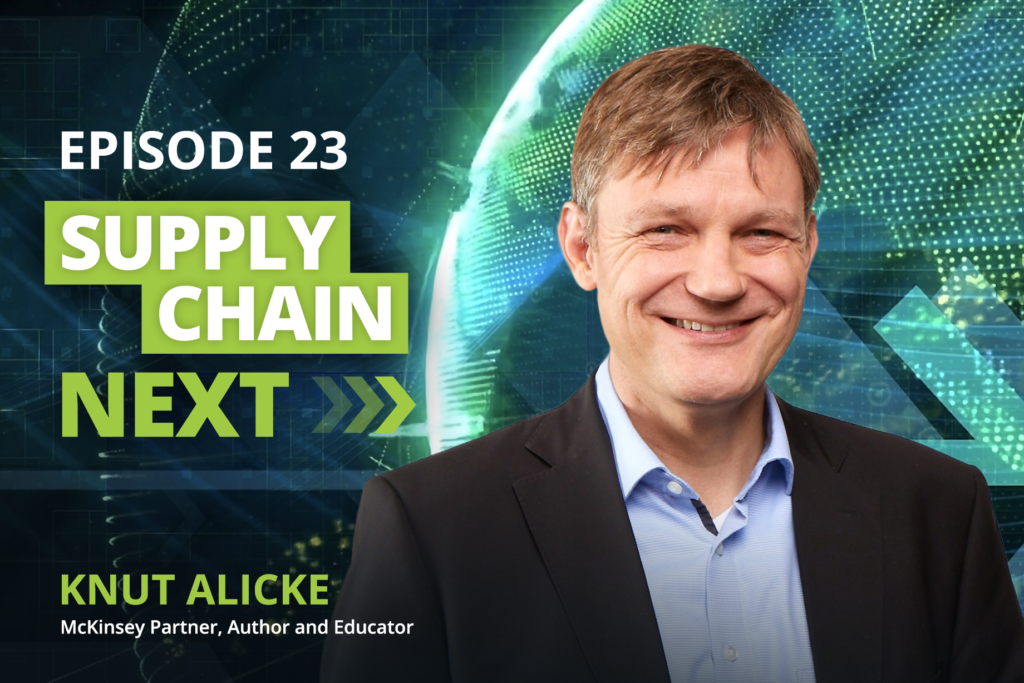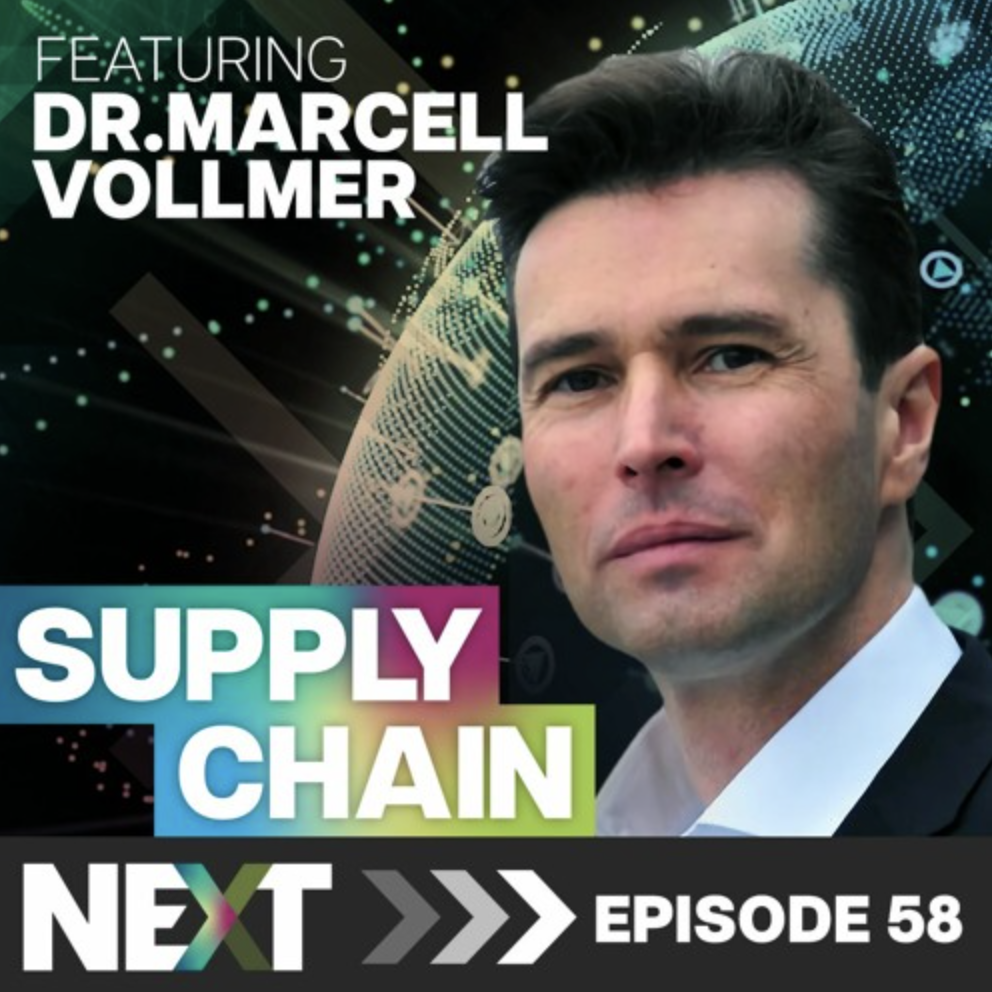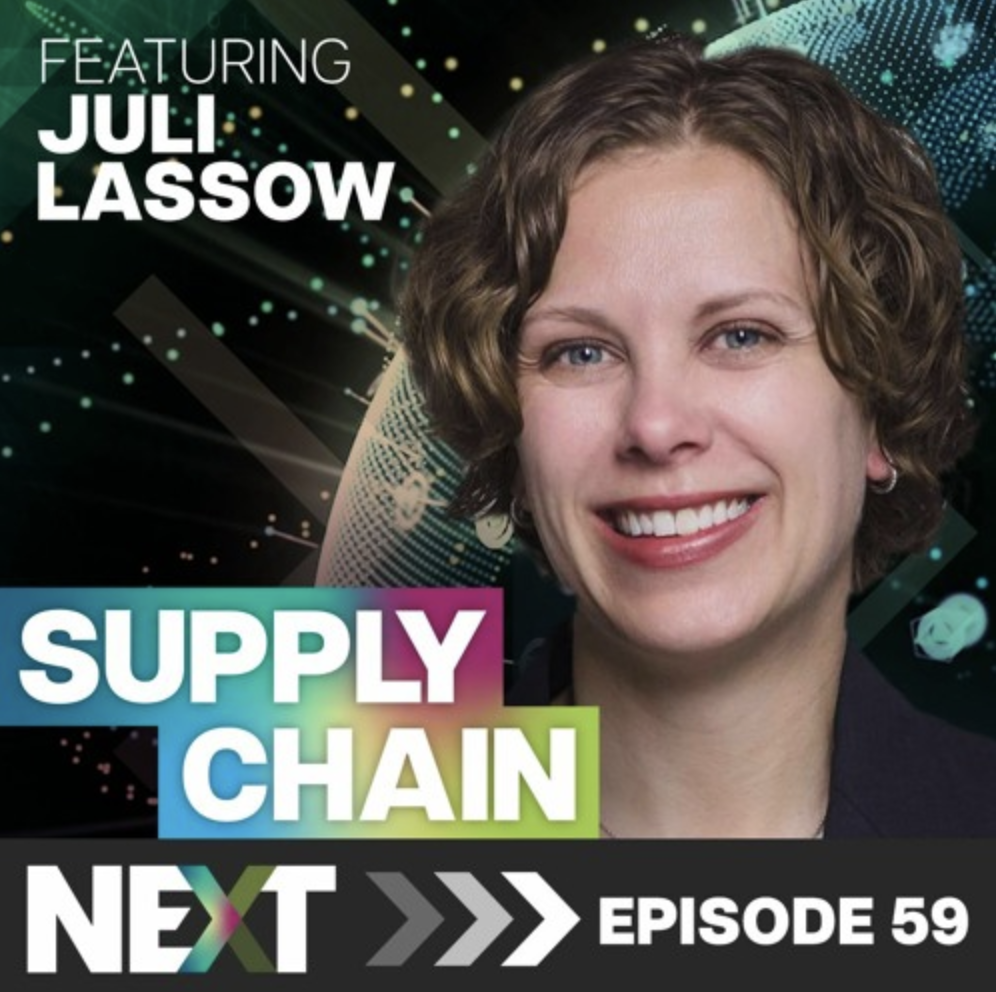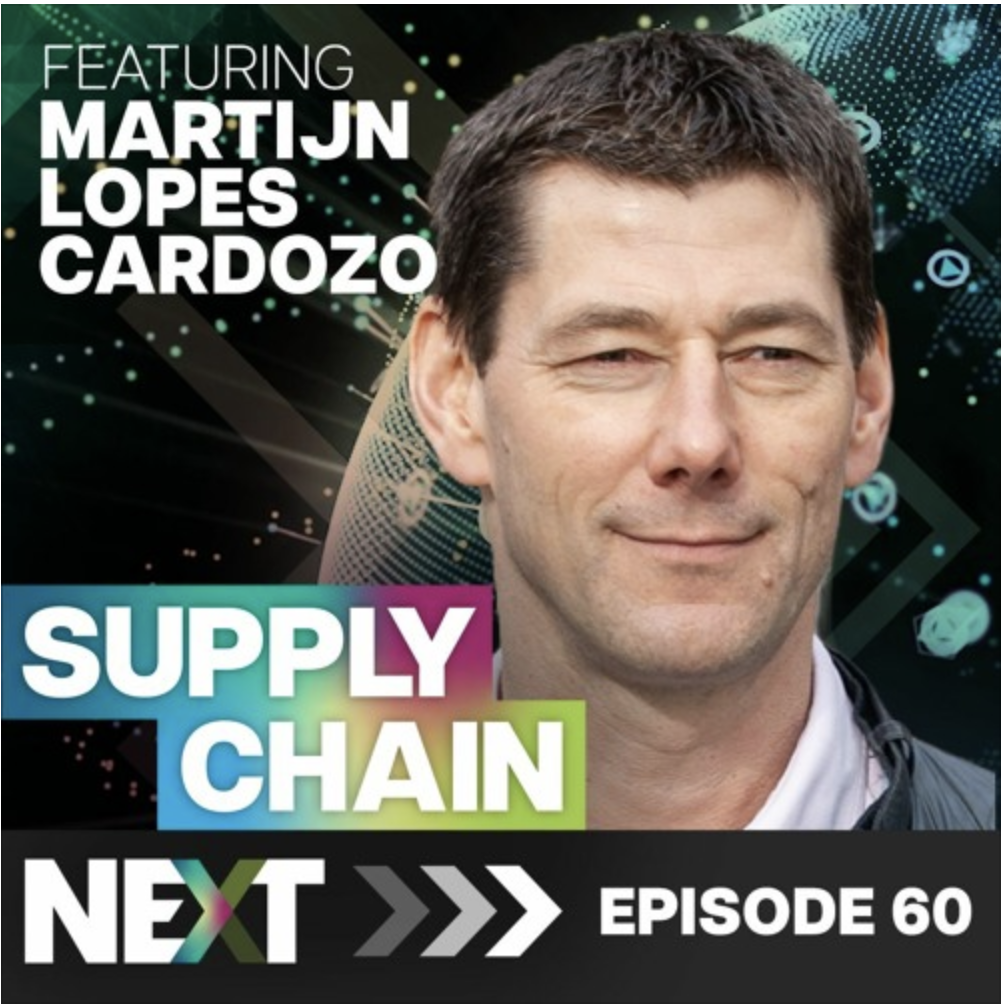EPISODE 23
Podcast: Predictive Analytics and Digital Transformation Pioneer Knut Alicke
Knut Alicke was helping to build digital control towers before most people had ever heard of them, and today advises the world’s top companies about supply chain.
He is based in Germany, and, as a founding partner of the supply chain practice at McKinsey & Company, consults on a variety of supply chain-related business problems, including S&OP and advanced analytics. He is also a professor at the University of Karlsruhe where he teaches supply chain management.
Knut has written a highly regarded book on supply chain (in German) and co-wrote several articles on the impact of COVID-19 on the world’s supply chains, including Resetting Supply Chains for the Next Normal, Supply Chain Recovery in Coronavirus Times—Plan for Now and the Future, and How Great Supply Chain Organizations Work.
On episode 23 of Supply Chain Next, Richard Donaldson talks with Knut Alicke about digital transformation and predictive data analysis. You can listen to the audio podcast below, or watch the video version on YouTube.

Highlights from the Conversation
I’d like to begin by asking: Knut Alicke, who are you? How did you get into supply chain?
- 25 years ago I finished my studies in mechanical engineering and my master’s thesis was on plant layout and logistics planning.
- I found logistics, hardware logistics, and warehouse planning very interesting. This is where I focused my efforts toward my PhD.
- Back then I was working on difficult optimization problems, what I called “multi-stage sequencing” which you have in warehouses.
- Two colleagues and PhD students from my Institute started a company, ICON GmbH, that focused on helping organizations plan their operations. Soon after they started that company, they met with Hewlett Packard (HP) to help them improve their supply chain operations.
- HP was using an SAP system for their operations. SAP had announced a new planning system that they called APO but it was about two years from being released. HP asked for help in the meantime. In about six months ICON had the first version of the planning system. It became the most used planning system in HP back in those days.
- We expanded into automotive. We had a visionary system, which focused on multi-tier transparency.
Some of the OEMs in the automotive industry struggled with the end-to-end processing of leather, which came from South Africa. It was a seven tier supply chain. They had issues on the fourth tier. - We developed a monitoring system with a web interface for them. It provided a control tower view of their supply chain. They could see the entire supply chain right from the first request for materials all the way to the source of the materials in South Africa.
So you were in the process of creating early supply chain platforms that provided transparency? How were you able to do that back then when the Internet was so young and there was no real Internet of things (IoT) quite yet?
- In the late 1990s the most innovative part of an automotive supply chain was to use web-based portable database images (PDI).
- When there’s a real need to solve a real problem implementations are initiated faster. Both Daimler (Mercedes-Benz) and BMW had line stoppages with a non-available part so they couldn’t continue production. This got them thinking.
- We had to help them find a way to keep the required materials in the right amounts at every step of the supply chain.
- In the beginning we just used simple text files to collect the data which was sent over a secure connection to the analysis system. As the years went on it became more efficient but still needed improvement.
So, at that time you were trying to create transparency around the supply chain with an emphasis on collecting existing data and looking for constraints on the system, similar to the LEAN method developed by Toyota?
- Exactly. The constraint was capacity and this was a challenge since it was leading to shortages in inventory.
- If something goes wrong it is easier to adapt if your system is able to produce real-time data quickly so a fix can be identified and implemented as soon as possible.
- Back in those days a lack of communication between tiers also produced shortages. This is the reason why transparency across your supply chain is so important.
- You can’t let anybody run out of the things they need to keep up production. It takes time to rebalance the whole system so everybody has what they need at their position within the supply chain.
You’re talking about the first phase of supply chain optimization known as “demand planning”. Everything you’ve spoken about is concerning the avoidance of shortages of supply during operations while demand is increasing. Is that a simplified way of looking at it?
- Yes, that’s fair. The OEMs did provide estimates on demand. It was not something that we had to forecast. Today we would use demand sensing, machine learning (ML), and other tools to predict demand.
- Back then the plan was to calculate the demand starting from the OEM and down through the supply chain.
- Inventory optimization: that’s a very important point. We started to use color coding to show inventory levels. This helped us with the multi-tier inventory system.
- Some smaller companies took notice of our planning methods and began to use them as their ‘planning system’ because they liked the results that we were getting.
It sounds like you made the early version of a supply chain platform? What happened to that?
- We are all really proud of what we made: an award winning logistics system.
- Back then there was a shortage of computer chips in the electronics supply chains, so we applied our methods to that with success to help prevent disruptions.
- Our system solved shortages and without shortages you don’t need a system to keep track of anything. Transparency only helps if there’s a problem somewhere.
- The same problems exist today especially with COVID-19. Our clients are looking for risk mitigation methods. It could be double sourcing, capacity, agility, inventory, and more.
- Clients today want to see the business cases. They want to know how their supply chains can be improved and how to be prepared for disruptions.
- Our McKinsey report: Risk, Resilience and Rebalancing in Global Value Chains, showed that we have a major disruption of global supply chains every three to seven years. People still don’t get that they need to prepare for the unknown. They see their supply chains working during the times when there are no disruptions and claim they don’t need transparency or predictive safeguards.
- The automotive industry said they didn’t need transparency so they stopped using it. Consumer electronics, who have more disruptions at a smaller scale, began to use transparency within their supply chains.
So you left the technology world and joined McKinsey. That’s a big transition. How did that happen?
- It happened by coincidence. A colleague at McKinsey, who was managing the supply chain practice, read my book on supply chain and approached me and asked me to join McKinsey.
- (Editor’s note: Knut’s book is currently available in German only.)
- I joined McKinsey in 2004 and I’m still enjoying my time there.
- I’m pushing the supply chain agenda. I want to help our clients improve their supply chains.
- I’m always looking for the latest and greatest in digital innovations and also learning about better ways to implement change within supply chains.
- I also ask my clients if they have a marketing budget for supply chain so they can explain what supply chain is to the relevant people.
- We have to make supply chain simpler and easier to understand for a company and its C-Suite.
So you’ve seen the evolution of supply chain over the last twenty years. It seems like the world is only catching up to where you were twenty years ago. What have you witnessed in how the enterprises are learning to move toward digitalization today?
- When we did work for HP we were able to navigate their supply chain fully. We could set up whatever we needed. It was quite advanced, a real, global supply chain that processed thousands of orders and products at every step of the way.
- I expected to take some 5 years until everyone would use those planning systems/approach, apparently this was not the case.
- HP was very advanced in their operations. They had several integrated layers for planning.
- When we would go to help a new company to get their supply chain organized we would discover that they had no end-to-end planning in any form. This has changed a little over recent years but it’s not quite there yet. Better end-to-end planning is still needed across the board.
- Supply chain is a new topic. It’s not like manufacturing which has been around for decades so there’s still a long way to go.
- In the last sixteen years I really feel like I’ve increased my work on the “soft side” of supply chain: to explain, to implement, to align incentives.
- I am always wondering, what else can be achieved with technology?
For a long time supply chain has been misunderstood as logistics and procurement and not thought of as an end-to-end identity. When you think about end-to-end supply chains, what does that mean to you? What does that mean to your clients?
- Amazon was the one responsible for the “customer centricity” perspective. So this is where the supply chain begins: the customer. We then work our way backward from the customer to the supplier. This is where the understanding of demand sensing technology really comes through. Then it is time to make predictions on the demand. These predictions run backward from the customer and form the entire supply chain.
- If it’s a retail environment we aggregate the data to get a clear view of their requirements.
- We need to work with their suppliers.
- From the customer to the suppliers: this is end-to-end.
Do you consider going all the way back to the natural resources beyond the supplier in your transparency solutions? How do you see recycled materials contributing to the circular economy?
- We are starting to look at the circular economy. We ask ourselves, how can we reuse the materials in our supply chains? How can we return the flow of materials from us to our suppliers?
- The last decade focused on digital. This decade will be focused on sustainability and circularity.
- The materials go from the supplier to the customer, the data flows from the customer to the supplier.
You started your career driving technology into supply chain. And then you’ve got this sixteen year period where you got to see some of the biggest supply chains in the world. All of this on top of your prolific writings on technology such as blockchain, IoT, and ML. How do you cut through these buzzwords to explain what these relevant technologies are and how they’re useful to supply chain?
- First off it’s really important to understand the technology and how it is useful for the business. You must make sense of it first. Then check the business case and see if it applies to your needs.
- Then you have to ask, how is this technology making our processes more efficient? This step can take time to produce results when starting out.
- My clients ask us from time to time about blockchain. I always struggled with blockchain. It just isn’t quite usable for large scale applications yet. It doesn’t make sense to use it today but might make sense in the future.
- We work with the World Economic Forum on creating the Global Lighthouse Network, a community of manufacturers leading the Fourth Industrial Revolution (4IR): hyper-advanced manufacturing facilities that bring enhanced value, data collection, and predictive analysis to enterprise operations at scale.
So how do we get the biggest companies in the world to move toward digitalization of their supply chains?
- Many companies jump onto the digitalization train. They hire a bunch of data scientists, put them into a corner and say, “Hey, do cool stuff!”
- Six months later, when the cool stuff is complete, the companies would determine it didn’t help improve their business, so they would decide that they didn’t need help.
- We also hired many data scientists and found them useful. But data scientists don’t understand consulting. Consulting doesn’t understand data science. So we needed to bridge the gap between them to make their analysis usable in the business world.
- The company needs to scale according to the information the data scientists provide.
- All companies are tech companies now. We connected traditional companies with startups to open the dialog about how to create a tech organization from a company culture point of view.
- Changing a traditional company into a modern, tech-culture company is a lot of work. Not everybody in the company has to change to accomplish this.
- The CEO of Daimler said some years ago he wanted to rearrange his company into only two or three hierarchical levels. This will take time. The reduced complexity within the company’s culture (ranks) smooths out operations.
- Aiming for a tech mindset is an important goal for companies today.
You wrote a piece in 2015 about how everybody must be cross-functional within the company to optimize the supply chain: The DNA of Supply Chain Executives. How do you integrate the current state of technology that exists now with what you wrote in 2015?
- That’s an interesting question. There is a need to be curious about innovation, how the automation processes collect the data, and how the data scientists analyze the data.
- Stay young, stay curious.
- It is highly beneficial for the older and younger generations to learn from each other.
How do you feel about the continuing trend of companies seeing themselves as technology companies, even if they only manufacture clothing, like Nike?
- Tech-savvy people are required at all steps in the supply chain leading right up to the customer. People can buy online, return in-store, buy in-store, return online, etc, so everything has become more complex with many more added processes.
- Businesses use more technology than ever these days so people who can understand the new tech are really important.
- The more tech-savvy people a company has the faster they can become more successful and start to innovate.
- Homegrown systems are where the real innovation starts. Not long after a company creates something new there will be others following suit.
In the last few years we are seeing supply chain-specific platforms emerging. What are you seeing now in that trend?
- If we look at how investor money has travelled into the software world over the last few years, we can see mostly hype, but it’s good that there is money there because they can develop all of their ideas.
- There are a lot more startups nowadays.
- It is worth analyzing what Google and Amazon are doing with their platforms. Their ML algorithms are now available for their customers.
- The big push toward the cloud has been very interesting. It centralizes the user experience and allows for frequent updates.
- Take a look at the LEAN system from Toyota. Everybody uses that now. The supply chain world doesn’t have anything standardized to this level yet.
Can the world’s supply chains live on standardized platforms? Are there enough commonalities to accommodate this emerging ideal?
- That is a good question. There are elements that are exactly the same between different industries but there are differences too. B2C and B2B can have different bottlenecks and B2C usually has more data available to process and analyze.
- Different algorithms may be chosen by different people for different industries in a shared environment. This could create problems.
- Supply chain is too complex for standardization.
What tech trends do you see emerging with your clients going forward into this very interesting “decade of supply chain”?
- Let’s start by looking at last year with COVID-19. Companies who had a strong digital infrastructure for their supply chain had very little problems running their operations remotely.
- Companies who weren’t set up for remote work had many challenges during the first months of the pandemic.
- The “just in time” culture has increased efficiency. Companies are looking into resilience and understanding that things should be done “at the right time” and not as fast as possible.
- Agility is important. Being able to change and adapt quickly helped many companies as the pandemic continued.
- We will see more digital backbone infrastructure.
- The pandemic has forced executives to think more about supply chain. This means that important topics such as sustainability are at the center of discussions.
- We will see more companies digitalizing their operations.
More About Knut Alicke
Knut can be found at McKinsey & Company and is ready to connect on LinkedIn.
More Episodes
You can listen to our audio tracks and read highlights for each episode below.
We’ve also started publishing video episodes on our YouTube channel.
058 – Dr Marcell Vollmer – Tech in Supply Chain, and the Sustainability Shift
Supply Chain Next · 058 – Dr Marcell Vollmer – Tech in Supply Chain, and the Sustainability Shift Meet Dr. Marcell Vollmer Dr. Marcell Vollmer, a renowned expert in the fields of digitalization, innovation, and sustainability. Marcell is a sought-after speaker and author that has dedicated his career to helping companies and individuals navigate the rapidly…
059 – Juli Lassow – Revolutionizing Retail, Sustainable Strategies, & the Future of Partnerships
Supply Chain Next · 059 – Juli Lassow – Revolutionizing Retail, Sustainable Strategies, & the Future of Partnerships Juli Lassow ,founder of JHL Solutions Meet Juli Lassow Juli Lassow, an accomplished retail professional, speaker, writer, and sustainability advocate, is the founder of JHL Solutions, a consultancy focused on creating outstanding private-label partnerships. With a deep…
060 – Martijn Lopes Cardozo – Circular Supply Chain
Supply Chain Next · 060 – Martijn Lopes Cardozo – Circular Supply Chain Martijn Lopes Cardozo, CEO at Circle Economy Meet Martijn Lopes Cardozo Martijn, a seasoned entrepreneur, has an impressive track record of establishing prosperous ventures within the realms of software, mobile, and digital media in California. Upon returning to the Netherlands, he…



